Laptop Mag Verdict
The Sony Xperia ZL features a superb camera, a 5-inch full HD display and powerful processor for unlocked phone fans, but you don't get enough battery life for your money.
Pros
- +
Powerful quad-core processor
- +
Superb camera
- +
Excellent audio quality
- +
Can be used as TV remote
Cons
- -
Below-average battery life
- -
Limited viewing angles
- -
Oddly placed front-facing camera
- -
Very expensive
Why you can trust Laptop Mag
A close cousin to the water-resistant Xperia Z, the Xperia ZL offers most of the same goodies without a contract. An unlocked device designed to ride on either AT&T or T-Mobile, the ZL packs a 5-inch full HD display, quad-core processor and one of the best cameras we've ever used on a phone. However, $759 is a lot of cash to spend on a phone, regardless of the specs. Find out if this Xperia lives up to its sticker price.
Design
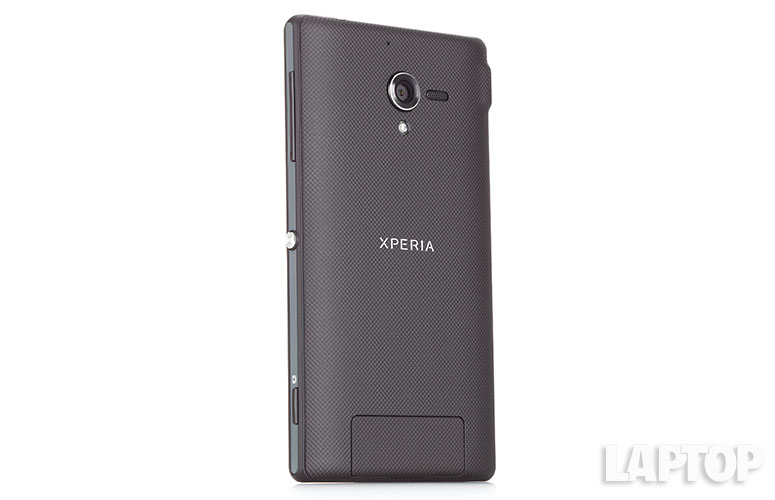
Click to EnlargeThe Xperia ZL follows Sony's OmniBalance design scheme, which is meant to lend the phone a sense of symmetry in all directions. Haughty terminology aside, the ZL is a slick, modern-looking smartphone. Its thin bezel helps accentuate the handset's 5-inch display, while its chrome edging lends the phone a premium look. While our review unit came in black, shoppers can also opt for a red or a white version.
Two things really stand out on the ZL. First, you won't find any hardware buttons beneath the screen because the Home, Back and Recent App buttons are integrated into the software. Second, contrary to standard smartphone design, Sony placed the ZL's front-facing camera below the display, rather than above it. This means that when making video calls, others will have to look up your nose until you raise the camera closer to your forehead.
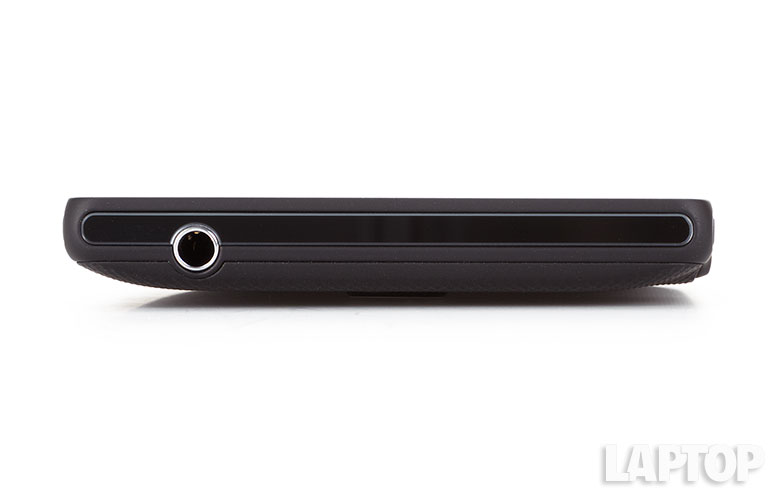
Click to EnlargeTo the left of the camera is the ZL's status indicator, which glows red, making the handset look like K.I.T.T. from "Knight Rider" whenever it's charging. On the ZL's right edge are the phone's volume rocker, circular power button, dedicated camera button and nearly invisible IR blaster. We especially liked the positioning of the power button, as it made quickly locking and unlocking the phone with one hand a snap. The phone's left edge hosts a microUSB port, while the 3.5mm jack sits on top.
Sony chose to cover the rear panel with a textured rubber material that makes the phone easy to grip. The back also houses a 13-megapixel camera and flash, inlaid silver Xperia emblem and a flap that covers the microSD card and SIM card slots. Note that the back panel is not removable, so that battery will stay put.
At 5.4 ounces and 0.39 inches thick, the Xperia ZL isn't the most svelte handset. The HTC One, which sports a smaller 4.5-inch display, weighs just 5 ounces and measures 0.36 inches thick, while Samsung's 5-inch Galaxy S4 weighs 4.6 ounces and measures 0.31 inches.
Display
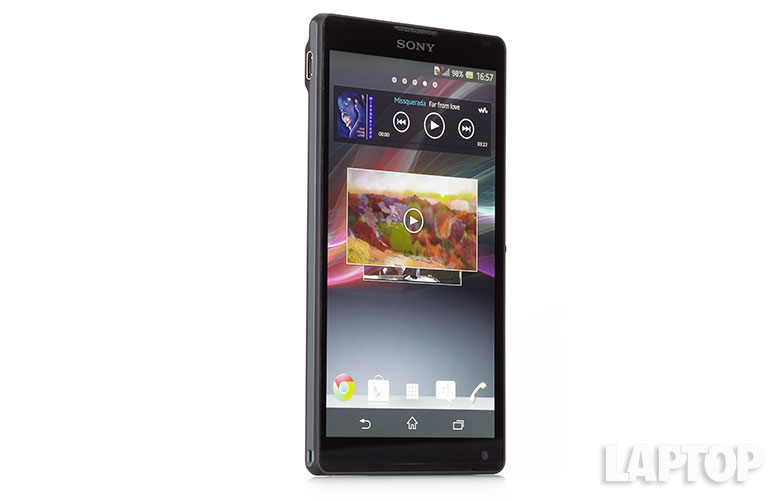
Click to EnlargeMeasuring 5 inches, the ZL's 1080p Reality Display offers an impressive 443 pixels per inch. That's more than the Galaxy S4's 441 PPI, but less than the HTC One's 468 PPI. What sets the Xperia ZL apart from the S4 and One is its Bravia Engine 2 technology. Borrowed from the Bravia TV line, the Bravia Engine 2 is meant to improve video and photo image quality via real-time contrast optimization, color management, noise reduction and a sharpness filter.
When viewed head-on, the Xperia ZL's panel offered better performance. While viewing a trailer for "Iron Man 3," minute details such as scratches on Iron Man's armor and small pieces of debris following a large explosion were easily visible. Without the Bravia Engine activated, colors, such as the reds and blues found on the Iron Patriot's armor, appeared dull and muted. But when we switched on the Bravia Engine 2, colors warmed up considerably and looked far more vibrant.
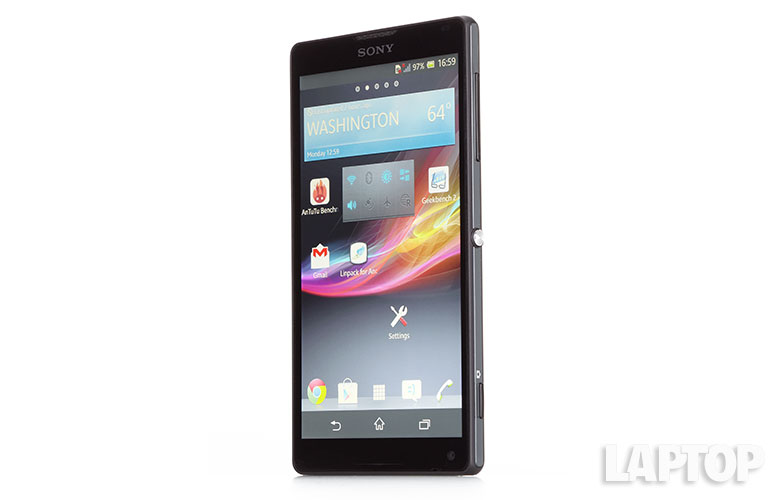
Click to EnlargeHowever, the ZL's display looked washed-out when placed side-by-side with the HTC One. The ZL's viewing angles are too narrow, resulting in a cloudy image when you view content from the sides. That's a bummer when you have such a large canvas, which invites the sharing of content.
The Xperia ZL's display registered 430 lux on our light meter, which is higher than the smartphone average (374 lux), but behind the HTC One (463 lux). That said, the Xperia ZL's OptiContrast display, which reduces glare by removing a layer of air between the screen's lens and sensor layers, means you'll be able to use the handset in bright sunlight without issue.
Audio
A single rear-mounted speaker pulls audio duty for the Xperia ZL. Whether we were listening to hits from the Black Keys or Notorious B.I.G., the ZL's speaker offered loud, clear audio. If you really want to pump up the volume, you can switch on the ZL's xLOUD setting. Sure enough, sound was much louder when we turned on the feature, though we noticed a small drop in overall audio quality. On the other hand, the HTC One's dual front-facing speakers and Beats Audio software blew away the ZL, pumping out solid bass hits and crisp vocals.
If you're looking for a more refined listening experience, you can use the Clear Phase setting, which improves audio quality, but reduces the speaker's maximum volume. In general, we preferred to use the Clear Phase setting, because it resulted in cleaner-sounding audio.
Keyboard
The ZL comes with Sony's standard Xperia keyboard, which offers the same functionality of the basic Android keyboard, but adds a Swype-like Gesture input feature. The Xperia's keyboard also provides three layout options: a standard QWERTY keyboard that requires you to press a dedicated button to access numbers and symbols, a version that enables long presses to enter numbers and symbols and a classic flip phone-style number pad layout.
MORE: 5 Go-To Keyboard Apps for Android
If the default gray-and-white keyboard skin doesn't tickle your fancy, Sony offers two additional skins, white on white and gray on gray. Sony also lets you decide whether you want to add dedicated period, comma and smiley face keys (for emoticons). Overall, we typed fairly quickly, especially when we turned off haptic feedback, and appreciated the suggestion area above the layout. We just wish the software automatically entered a space after you choose a word.
Software and interface
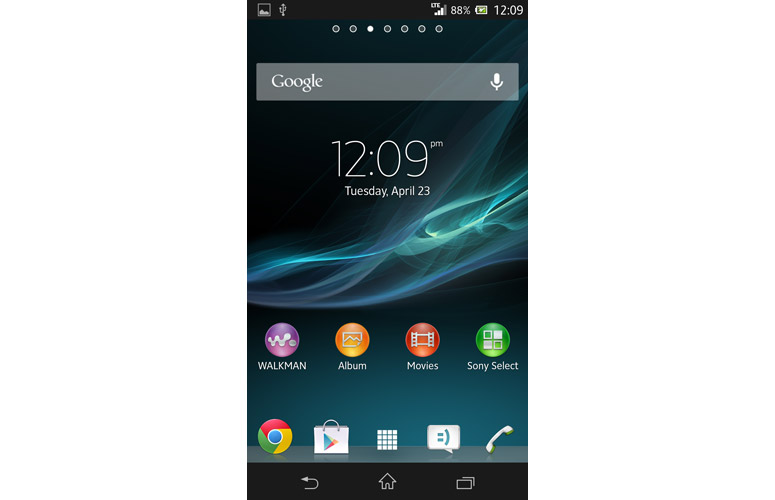
Click to EnlargeThe Xperia ZL offers a lightly skinned version of Google's Android Jelly Bean 4.1.2. From the lock screen, users have the option of swiping to open the camera app, music player or simply unlocking the handset. Unlike the HTC One, the Zl doesn't allow you to add apps to the lock screen. The only changes you can make are the lock screen wallpaper and the type of lock you use, whether that be a PIN, pattern, face or swipe lock.
The ZL has five customizable home screens, two of which are blank. The main home screen includes a Google search bar, clock widget and shortcuts to the Walkman, Album, Movies and Sony Select apps. A second home screen includes Walkman and Album widgets, while a third screen features weather and tools widgets. At the bottom of each home screen are shortcuts for the Chrome browser, Google Play store, Apps Drawer, Messaging and Dialer. Below those are the ZL's ever present Back, Home and Recent Apps buttons.
Swiping down from the top of the screen reveals the ZL's Notifications menu with a shortcut to the settings menu, as well as controls for the handset's ringer, Bluetooth, Wi-Fi and Mobile Data functions. However, we wish there were shortcuts for brightness and Airplane Mode here.
The ZL also includes NFC technology, enabling users to share apps and photos via Android Beam or tap to pair with several Sony Bluetooth devices.
Media sharing
As with most new Xperia phones, the ZL includes a host of media sharing and streaming options, including screen mirroring, media throwing and media server functionality. The screen mirroring option allows users to share whatever they are viewing on the ZL with another device, such as a television, while the media throwing option lets you send media from the ZL to another device. The media server function lets you share content stored on the ZL with other devices over the same Wi-Fi network.
Apps
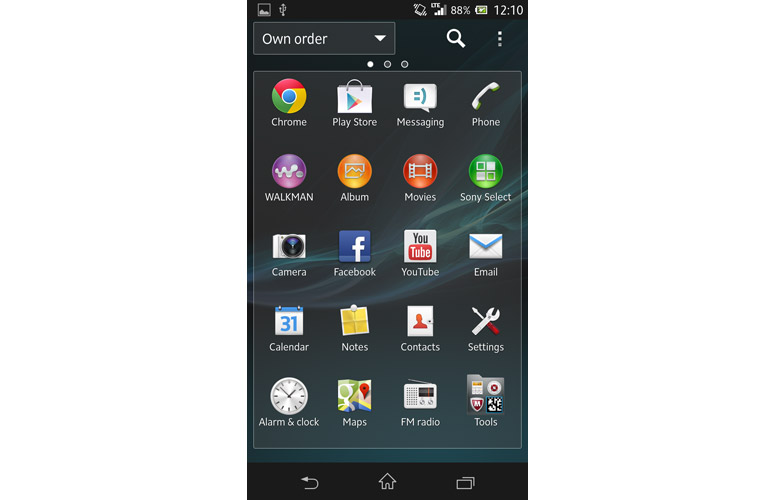
Click to EnlargeThe Xperia ZL is practically bursting at the seams with a melange of bundled apps. Beyond the usual Google apps (YouTube, Gmail, Google Talk, etc.), Sony loaded the ZL with the aforementioned Walkman, Album, Movies and Sony Select apps. Other apps include McAfee Mobile Security, Office Suite, WisePilot for Xperia navigation and the Socialife app, which aggregates interesting articles and photos from your Facebook and Twitter feeds and provides them to you in an easily consumable layout.
MORE: 10 Best Android Apps You're Not Using
The ZL also includes Sony's Xperia Link hotspot app and Smart Connect, which, similar to Motorola's Smart Actions, can be set to automatically activate or deactivate certain phone settings depending on the time of day or the kind of device to which you connect the ZL.
Like the HTC One, Samsung Galaxy S4 and LG Optimus G Pro, the Xperia ZL includes an IR Blaster for controlling everything from TVs and cable boxes to Blu-ray players and PC media centers. Setting up the app with our TV was quick and painless, allowing us to start channel surfing in about a minute. The one thing that's missing is some kind of smart channel guide, à la the HTC One's Peel-powered TV app. This omission is surprising given that the upcoming Xperia Z Tablet has a dedicated SideView app for finding great stuff to watch.
Performance
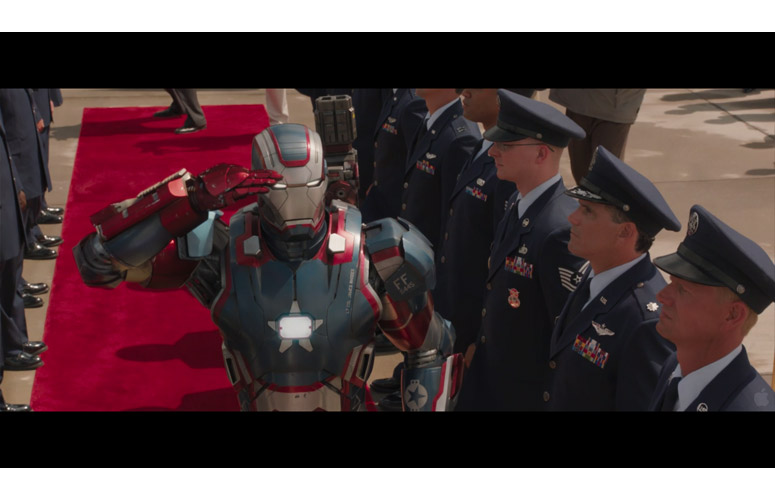
Click to EnlargePacking a 1.5-GHz quad-core Qualcomm Snapdragon S4 Pro and 2GB of RAM, the Xperia ZL offers more than enough firepower. It blasted through games like "Jetpack Joyride" and "Super Monsters Ate My Condo" without breaking a sweat.
The ZL also performed fairly well on benchmark tests, though it's far from the speediest handset. On the Quadrant benchmark, which tests a phone's CPU, graphics and I/O performance, the ZL scored 7,723. That's better than the category average of 3,949, but well below the 12,426 scored by the HTC One and its 1.7-GHz quad-core Qualcomm Snapdragon 600 processor and 2GB of RAM.
On the AnTuTu benchmark, which also tests a smartphone's overall performance, the Xperia ZL managed a score of 20,661. That's higher than the category average of 12,755, but lower than the 21,089 we recorded on the Galaxy S4 during our brief hands-on with the handset last month. The HTC One trounced all comers with its score of 24,295.
The ZL also performed well in the graphics department, scoring 7,332 on the An3DBench graphics test. That's better than the category average of 7,127, but just below the HTC One's score of 7,724.
Web browsing
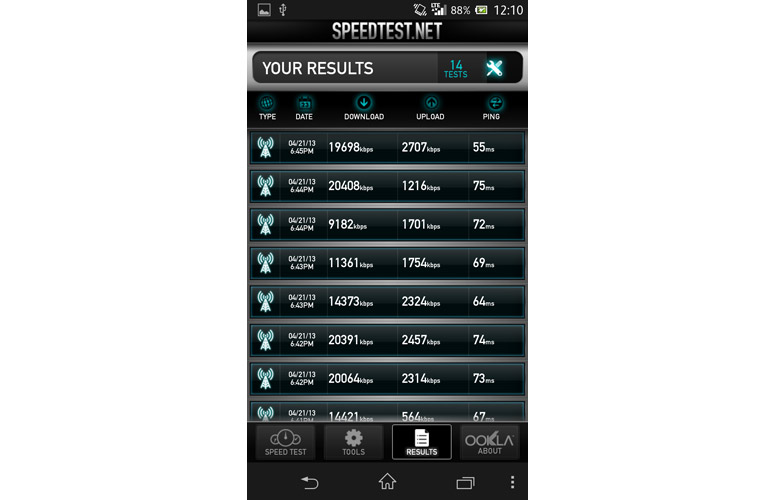
Click to EnlargeThe Xperia ZL is currently available in both unlocked 4G LTE and HSPA+ versions through Sony's online store. We installed an AT&T microSIM for our testing.
On the Speedtest.net benchmark, the Xperia ZL offered impressive download speeds that averaged 16.5 Mbps. Uploads were somewhat lackluster, however, averaging just 2.1 Mbps. Web pages loaded quickly, with both NYTimes.com's and ESPN.com's mobile sites loading in an average 3.7 seconds. The image-heavy Laptopmag.com loaded in 8.6 seconds.
Camera and camcorder
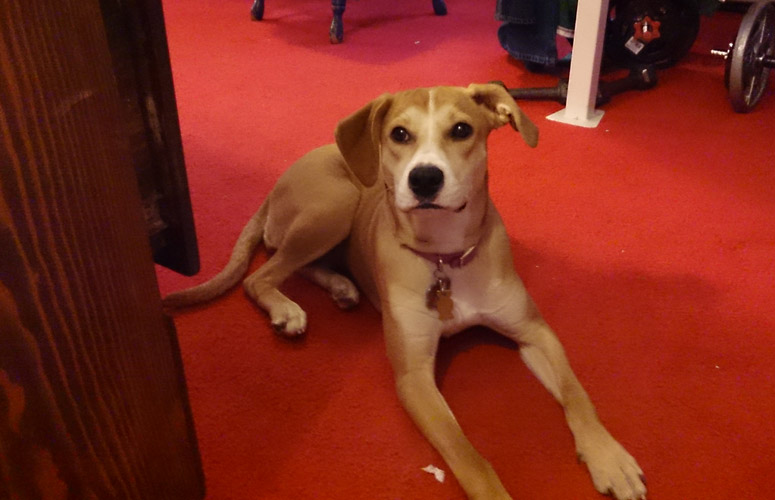
Click to EnlargeThe Xperia's 13-megapixel rear-facing shooter may just be the best smartphone camera on the market. Its features include HDR mode, Burst mode, adjustable ISO settings, Sweep Panorama and a host of other settings. If you want to use the best shooting mode for every situation, we suggest using the camera's Superior Auto mode.
During our testing, we were struck by how crisp and colorful each of our photos looked. When we zoomed in on a photo of the Empire State Building taken from several blocks away, we were stunned that we could make out each of the tower's individual windows and the design of the building's famous spire.
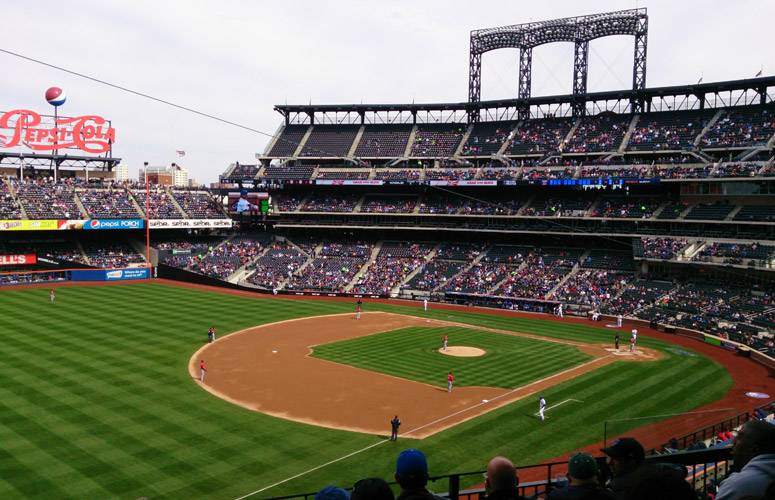
Click to EnlargeThe Xperia's camera also performed well in other environments. While at a Mets game, the Xperia captured a clear image that showed off the warm sunlight covering the field.
A 1080p HDR video shot using the rear-facing camera offered vibrant colors and never looked washed-out, even when filming while facing the sun. Details such as the bricks making up the facade of a far-off building were easily visible in our clip.
The ZL's 2-megapixel front-facing camera captured fine details, including individual hairs in our subject's beard, but its location in the bottom right corner of the ZL's bezel proved awkward. We found ourselves constantly repositioning the phone so that callers didn't have to stare at our nose hairs.
Battery life and call quality
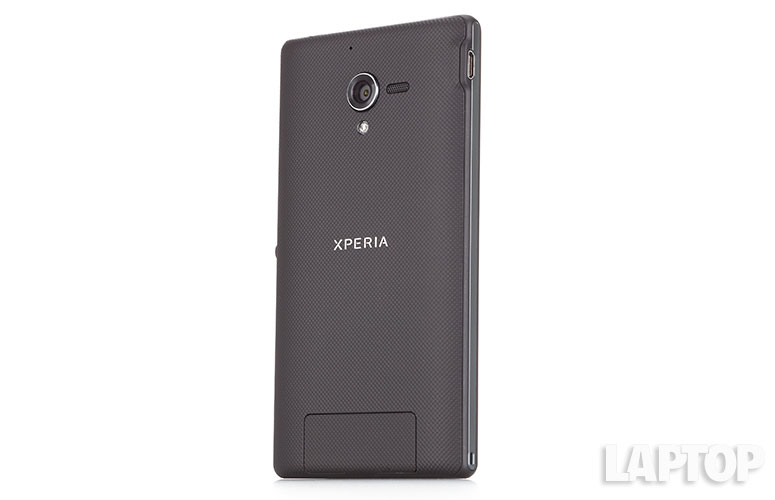
Click to EnlargeThose looking for long endurance from a phone should look elsewhere. The Xperia ZL's 2370 mAh battery lasted just 4 hours and 49 minutes on the LAPTOP Battery Test, which involves continuous Web surfing over 4G LTE on 40 percent brightness. That's well below the category average of 6 hours. The HTC One's battery lasted a similar mediocre 5:17, but engaging its Power Saver Mode extended the runtime to 7:50. (To be fair, this was over 3G, but we'd expect at least 7 hours of use over 4G LTE with Power Saver on.)
To help improve battery life, the Xperia ZL includes a Stamina Mode feature of its own, but it didn't make a difference on our test. However, you will likely see a battery life boost because of the way Sony's software saves power when you're not using the phone. Stamina Mode disables Wi-Fi and mobile data when the display is off and renders most apps inactive. You will, however, still be able to receive phone calls, text messages, calendar and alarm notifications and listen to the media player and FM radio.
MORE: Which Smartphones Last the Longest?
Call quality over AT&T's voice network was clear and crisp. The Xperia also offers a variety of sound improvement settings, including Microphone Noise Suppression, Speaker Voice Enhancement and Slow Talk, which can actually slow down the speech of the person on the other end of the line. Each of the features worked as advertised.
Sony offers both 4G LTE and HSPA+ versions of the Xperia ZL, but only on GSM networks, so you can only use the phone with AT&T or T-Mobile. The LTE version costs $759, and the HSPA+ only version is $719.
Verdict
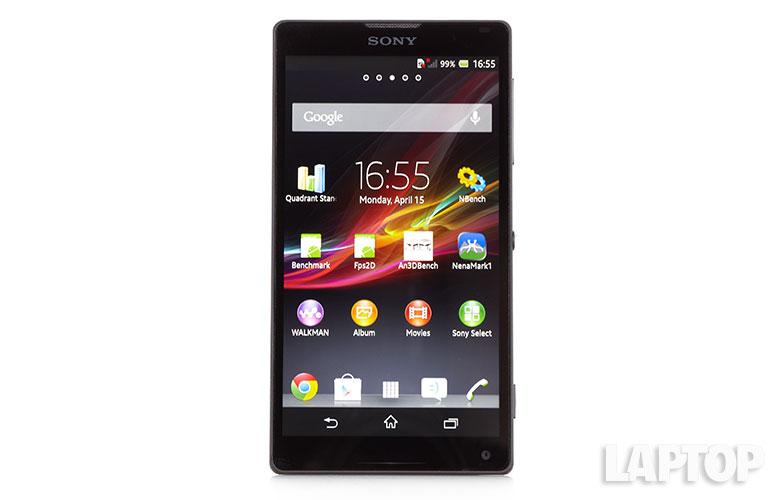
Click to EnlargeThe Sony Xperia ZL is a powerful handset with a superior camera, a premium design and excellent audio. However, the $759 price for this unlocked Android phone is pretty high when you consider that the HTC Developer Edition costs $649. (The unlocked One without the bootloader unlocked costs $549.) HTC's device offers much wider viewing angles and a faster processor, along with more sophisticated software for its built-in TV remote. But the ZL's 13-MP camera has the One's 4-MP shooter beat by a mile.
Our biggest complaint about the ZL is its below-average battery life, though you can squeeze more juice out of this handset in Stamina Mode. Overall, $759 is a lot to spend on an unlocked phone, especially one that doesn't quite beat Samsung or HTC in terms of features and endurance.
Sony Xperia ZL Specs
| Audio formats supported | OTA, OGG, MP4, MP3, WAV, SMF |
| Bluetooth Type | Bluetooth |
| Brand | Sony |
| CPU | 1.5-GHz quad-core Qualcomm Snapdragon S4 Pro |
| Camera Resolution | 13MP |
| Company Website | http://www.sony.com |
| Data | EDGE, UMTS, LTE, HSPA+, GSM/GPRS |
| Display (main) | 5-inch |
| Display Resolution | 1920x1080 |
| Form Factor | Candybar Touchscreen |
| Front Camera Resolution | 2MP |
| GPS | Yes |
| Internal Memory | 16GB |
| Memory Expansion Type | microSD Card |
| OS Family | Android |
| Operating System | Android 4.1.2 |
| Phone Display Size | 5 |
| Ports | SIM card slot, 3.5mm headphone |
| Processor Family | Qualcomm Snapdragon S4 Pro |
| RAM | 2GB |
| Size | 5.18 x 2.7 x 0.39 inches |
| Talk / Standby Time | 10 hours talk time, 500 hours standby |
| Weight | 5.4 ounces |
